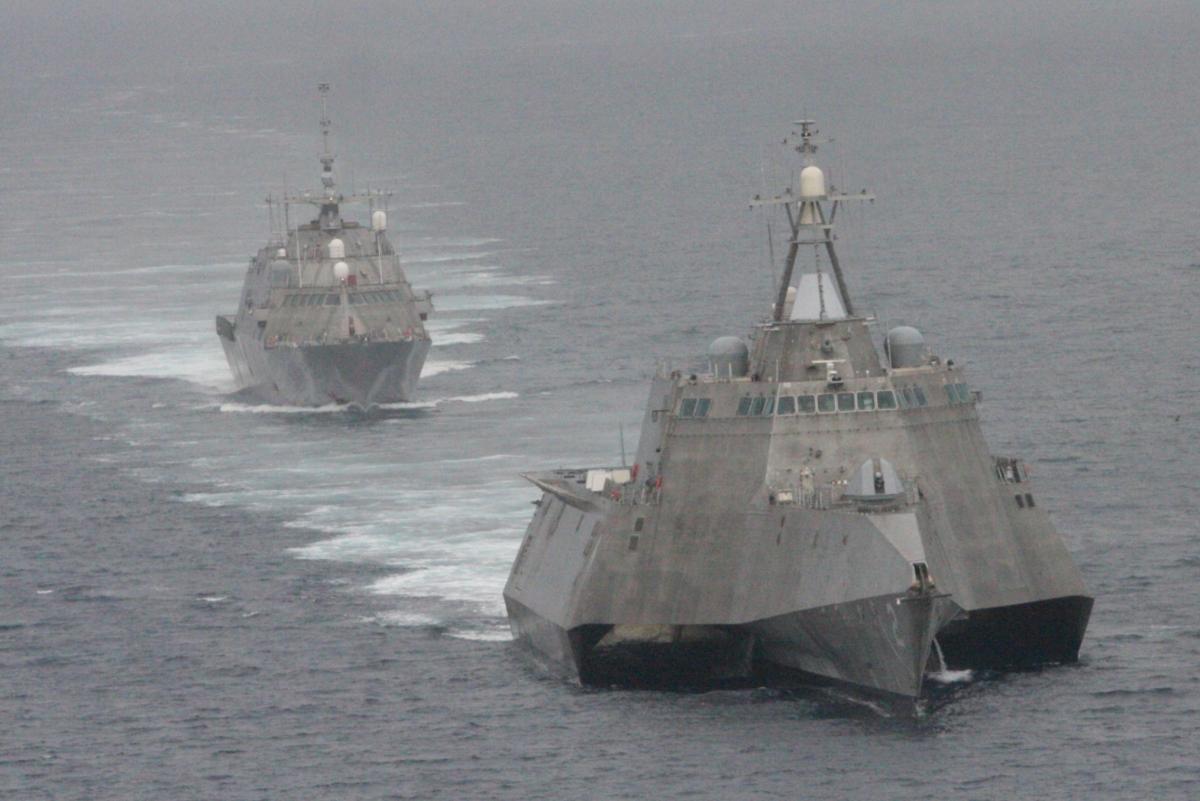
The Program Executive Office for Littoral Combat Ships hopes to take the helm of the Anti-Submarine Warfare Continuous Trail Unmanned Vessel (ACTUV) program and test it not only as a remote vehicle that conducts missions in tandem with the LCS but also as a host platform to launch other unmanned vehicles far from the manned ships controlling them, the PEO’s executive director told USNI News.
ACTUV was developed by the Defense Advanced Research Projects Agency (DARPA) and handed over to the Office of Naval Research this year for additional testing. Though its name highlights the anti-submarine warfare mission, it could also be important to the Navy’s mine countermeasures mission, Nidak Sumrean said after speaking at the American Society of Naval Engineers’ Launch and Recovery 2016 conference last week.
“It wouldn’t be launched and recovered off of an LCS, but it would play with an LCS in the sense that it could be controlled and operated from an LCS or a pier or a shore facility,” he said.
“Right now we’re working with ONR, based on the testing that’s ongoing, what would be the natural progression of testing from … ASW, mining and any kind of launching and recovering of other systems off of the unmanned system, if you will – so it could be like a host platform for other systems to be launched and recovered. So we haven’t figured out which systems would be on there, so the roadmap that we set up for ourselves is basically, first kind of operate it and see its capability envelope, and then be able to put some of the sensors that we currently own – CUSV (Common Unmanned Surface Vehicle), Knifefish, some of the other ones – on there and see how they could potentially operate.”
The unmanned vehicle, which PEO LCS is calling the Medium Displacement Unmanned Surface Vehicle, could even operate with unmanned systems outside the PEO LCS portfolio. For example, Sumrean said the PEO hoped to test whether MDUSV could launch a Large Diameter Unmanned Underwater Vehicle (LDUUV), which has previously been associated with launching from a Virginia-class attack submarine.
Sumrean said he needs the chief of naval operations’ warfare systems directorate (OPNAV N9) to budget money for the program transition from ONR to the PEO’s Unmanned Maritime Systems program office (PMS 406), which would hopefully happen in the Fiscal Year 2018 budget.
The MDUSV could have a wide range of applications for the broader surface ship community and is being viewed as a “ship of opportunity,” Sumrean said. PEO LCS hopes it could eventually take on offensive mining and other missions as “another host platform, since it is larger than a typical unmanned surface vehicle.” But other ship types may have a use for this kind of unmanned vehicle, he said. The fleet has already sent ONR several ideas for how to use ACTUV that are informing test plans, Sumrean said, and after the transition those ideas would go to PEO LCS for consideration.
“If the pull is enough, maybe we can build a fleet of those MDUSVs and we would be the PEO to procure those” for broader Navy use, he said.

US Navy Photo.
Additionally, PEO LCS is preparing for the completion of the LCS ship hull and the transition into the frigate design. Defense Secretary Ash Carter last year called for the 52-ship small surface combatant program to be truncated at 40, with PEO LCS down selecting from two shipbuilders to one by 2019, according to Carter’ plan. USNI News understands that the Navy’s current force structure assessment – to replace a 2014 FSA that calls for 308 ships, including 52 small surface combatants – is likely to call for a larger fleet and potentially more small surface combatants. Additionally, President-Elect Donald Trump has expressed interest in a 350-ship fleet that would almost certainly have to include a greater number of LCS/frigates.
Sumrean said the PEO has requested enough information from its two shipbuilders that it can do whatever the next administration asks of it. In the first step of a two-step process of contracting the frigate transition, request for proposals has already been sent out to Austal USA and Lockheed Martin, asking for pricing for a block buy of “up to 14” LCS ships, he said. Responses are expected back in the second or third quarter of FY 2017, with the current plan being to hold a straight price shootout, with the lower bidder receiving a greater profit – much like the DDG-51 two-yard competition.
“Once we get pricing from both yards on LCSs, which we know what it costs today, then the question is what is it going to take to take those LCSs to a frigate,” he said.
“And so that RFP will go out later in the 4th quarter of [FY 2017] and the proposals will come in in ‘18 – middle of ‘18, late ‘18 – and we’ll evaluate those.”
“We’re getting pricing from both yards, so that gives us the option to either downselect or, if we want to, continue with both, whichever path the leadership decides they want,” he said. “We could execute either path.”
Sumrean noted some uncertainty in the LCS/frigate vendor base, due to Carter’s decision to downselect and truncate the program. However, he said he is optimistic about the program’s role going forward, due to its size and its ability to launch and recover a range of unmanned vehicles.
“I think an LCS-sized frigate has a role in that” future fleet the FSA will outline, he said.
“If you’re a platform that can handle unmanned, obviously you’re going to be playing well in that mix.”





